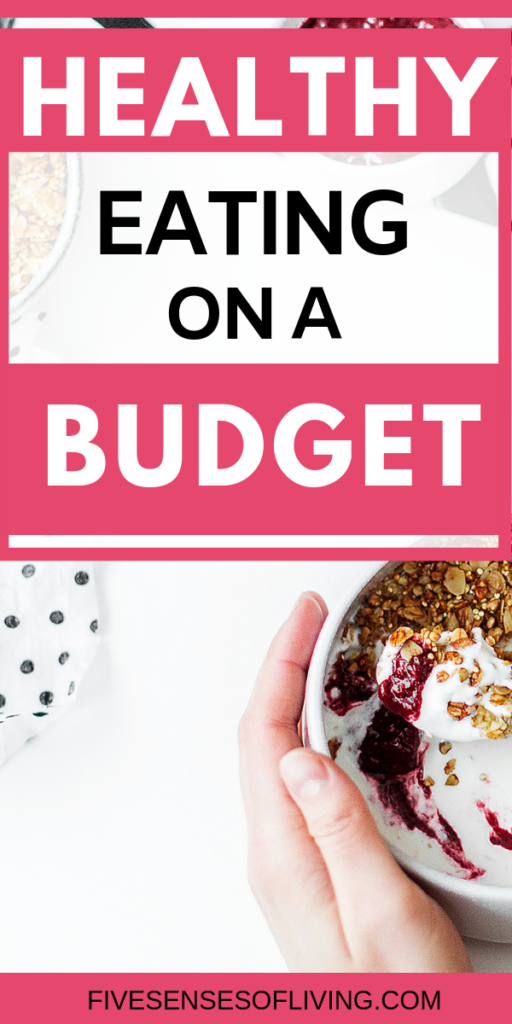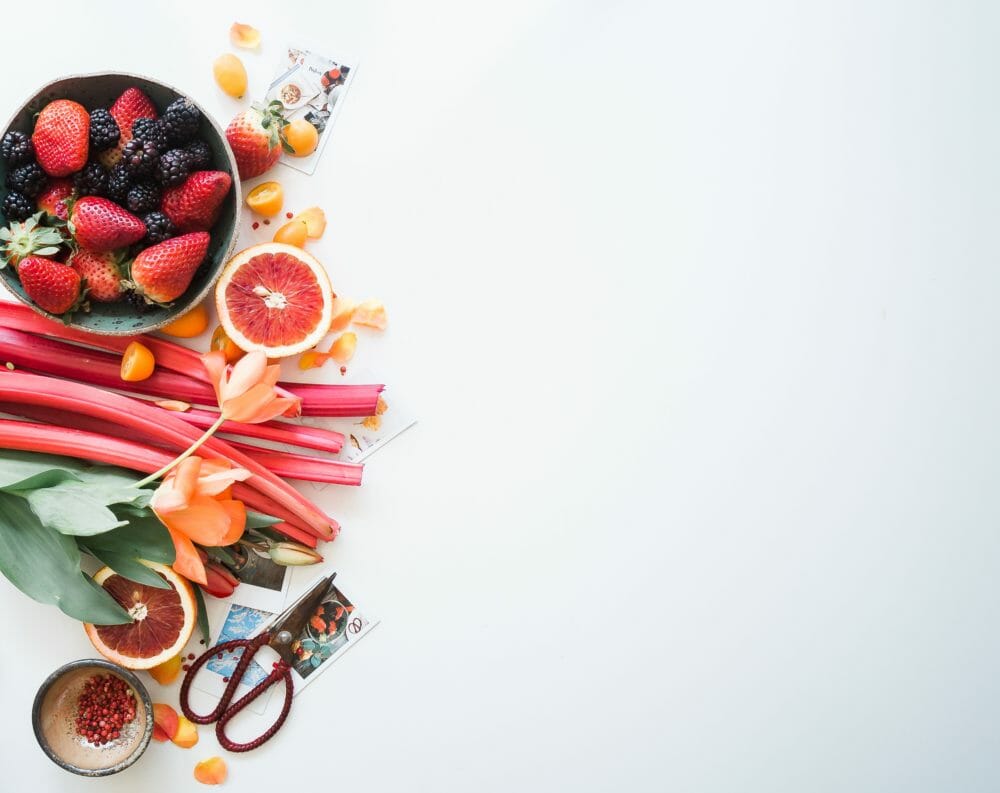Are you wondering what’s the cheapest most nutritious foods? Or maybe you’re thinking how can I eat clean for cheap? I love discovering healthy recipes that don’t cost a lot.
When you’re on a tight budget, or living paycheck to paycheck it may seem like it’s impossible to eat healthy. However, I’m here to tell you that you can do it!
You really can eat healthy foods while sticking to your budget. To do it successfully it takes a bit of planning, some creative cooking, and a little bit of knowledge.
With the information you’ll find here, you may discover that eating healthy on a budget isn’t so difficult after all. You may even find that you prefer to eat healthy and ditching the junk food is easier than you thought.
Table of Contents
Steps To Eating Healthy On A Budget
Plan Your Budget
To eat healthy on a budget you must first have a budget. If creating a budget is new to you- here’s a really good guide to get you started. By having a budget it will help you prioritize your purchases, keep track of spending, and allow you to see your spending habits.
Make A Weekly Meal Plan And Grocery List
Set aside some time to build a meal plan and grocery list. By doing this it will help you to only buy what you need and keep you from spending money on unnecessary things.
If you need help with meal planning I highly suggest you read this to get you started. Also, if you’re looking for some super yummy budget friendly recipe here’s one of my favorite food blogs check it out. Beth over at Budget Bytes has some fantastic recipes at super affordable prices.
Finally, write out your grocery list. When I write out my list I like to put a star next to any items that are optional. This means if I go over budget, the items that are starred can be put back on the shelf.
Please keep in mind, if you decide to just “fly by the seat of your pants” it’s going to make this whole eating healthy on a budget thing much more difficult.
When we get lazy and leave out the planning part of grocery shopping we end up wasting a lot of money! We either buy too much food (that ends up being wasted), we forget to buy a key ingredient, or we order takeout because become desperate.
Lets talk about meal planning again…. (I have a little secret if you aren’t into meal planning!) If you’re the kind of person who finds it difficult to meal plan or you just don’t have the time to do it I suggest you look into joining $5 Meal Plan.
Erin over at $5 meal plan does a fantastic job of creating budget friendly meal options. Most recipes will cost you $2 or less per person to make and they’re delicious.
Don’t miss the FREE 14 day trial Erin is offering right now.
Tips For Making A Meal Plan And Creating A Shopping List
1. Pick The Right Ingredients
Picking the right ingredients means picking fresh fruits and veggies that are in season. You’ll find a fantastic list of what produce is in season and when further below!
I’ve also created a FREE printable to put on your fridge so you always know what’s in season.
Picking the right ingredients also means that you pick healthy ingredients that can be used for multiple meals. Purchasing healthy staples like quinoa, lentils, black beans, and whole grain pastas are ingredients that can be used in many different meals.
2. Pick The Right Meals
What I mean by this is picking meals that you and your family can have for multiple meals. Perhaps you decide to cook spaghetti. – Cook enough spaghetti that you can have some for lunch the following day. This will save you money because you don’t have to spend money on going out to lunch.
Use Various Sources of Protein-Not just meat!
Meat, is often times the most expensive item you will buy for any meal. Instead of always using meat try and substitute a different protein such as beans, chickpeas or lentils. These alternative protein sources are super cheap and are full of protein and fiber, which will keep you fuller for longer.
How To Save Money At The Store
Remember Your Pantry
A great way to stock your pantry and save money on food is to buy staple items when you find them on sale. You don’t have to stock your whole pantry at one time, just buy a few staples when you find them on discount.
For Example: A bag of rice may seem a bit expensive upfront, but a bag of rice allows you to make several meals which will save you money over time.
Here are some basic staples to consider stocking:
- Rice
- Flour
- Canned tuna or chicken
- Canned beans and lentils
- Dry Pasta
- Canned tomatoes
- Spices
- Cooking oil
- Vinegar
- Milk (fresh, dried or both)
- Butter
- Eggs
- Onions
- Frozen vegetables
- Nuts and Seeds
- Quinoa
- Oats
- Parmesan or Mozzarella on sale– buy in bulk, split it into small portions, and freeze! I do this all the time.
Shop The Sales And Markdowns
Many grocery stores have a dedicated area for foods that are discounted as they begin to approach their expiration date. Don’t be afraid of these products!
If you are going to freeze it or eat it within a couple days, I highly recommend browsing the discount section. You really can save a ton of money!
Look For Discounted Meat
To save money on meat, always look for markdowns that are close its “use by” date. You can either use it right away or throw it in the freezer to use at a later time.
Additional ways to save money on meat:
- eat less of it
- make it go further by mixing it with veggies
- buy in large packs and divide it into smaller portions and freeze
To Organic Or Not To Organic?
When trying to eat healthy on a budget it can be hard to spend your hard earned money on organic foods. -I totally get it!
Trying to make ends meet and eating organic foods doesn’t always make sense. If you are the kind of person who would like to buy organic when your budget allows I suggest sticking to the “dirty dozen“.
The rule of thumb some people use for deciding when they should purchase organic or not comes down to skin on the fruit or vegetable. If the food has a skin that you don’t eat such as a grapefruit the thought is that the non-organic version is just fine.
However, some believe that fruits and veggies with a skin that you actually eat should be purchased organic.
If you need a bit more guidance in deciding what you should be buying organic and what you can buy non-organic here’s a list of the dirty dozen (buy organic) and clean fifteen (non-organic is fine).
The Dirty Dozen
- Apples
- Strawberries
- Grapes
- Celery
- Peaches
- Pear
- Spinach
- Sweet bell peppers
- Cherries
- Tomatoes
- Potatoes
- Hot peppers
The Clean Fifteen
- Avocados
- Sweetcorn
- Pineapples
- Cabbages
- Frozen sweet peas
- Onions
- Asparagus
- Mangoes
- Papayas
- Kiwis
- Eggplant
- Grapefruit
- Cantaloupe
- Cauliflower
- Sweet potatoes
Shop For In Season Foods
When you buy fruits or veggies that are out of season your grocery bill is guaranteed to be more expensive. When at the grocery store shop for items that are in season to save yourself a ton of money.
I’ve put together an “in season” list to help you identify which foods are in season and which aren’t.
Generally bananas, celery and potatoes are always consider to be in season.
January: Broccoli, Brussels sprouts, cabbage, cauliflower, grapefruit, kale, leeks, lemons, oranges, parsnips, rutabagas, tangerines, and turnips
February: Broccoli, Brussels sprouts, cabbage, cauliflower, grapefruit, kale, leeks, lemons, oranges, parsnips, rutabagas, tangelos, and turnips.
March: Artichokes, broccoli, Brussels sprouts, cauliflower, leeks, lettuce, mushrooms, parsnips, pineapples, radishes, rutabagas, and turnips.
April: Artichokes, asparagus, broccoli, cauliflower, leeks, lettuce, mushrooms, pineapples, radishes, rhubarb and spring peas. May
apricots, artichokes, asparagus, cherries, green beans, honeydew, lettuce, mangoes, okra, pineapples, radishes, rhubarb, spring peas, strawberries, swiss chard, and zucchini.
June: Apricots, blueberries, cantaloupe, cherries, corn, kiwi, lettuce, mangoes, peaches, strawberries, swiss chard, watermelon, and zucchini.
July: Apricots, blackberries, blueberries, cantaloupe, corn, cucumbers, green beans, kiwi, kohlrabi, lettuce, mangoes, okra, peaches, peppers, plums, raspberries, strawberries, summer squash, swiss chard, tomatoes, watermelon, and zucchini.
August: Apples, apricots, blueberries, corn, cucumbers, eggplant, figs, green beans, kiwi, lettuce, mangoes, peaches, peppers, plums, raspberries, strawberries, summer squash, swiss chard, tomatoes, watermelon, winter squash, and zucchini.
September: Acorn squash, apples, beets, butternut squash, cantaloupe, cauliflower, eggplant, figs, grapes, green beans, lettuce, mangoes, mushrooms, okra, peppers, persimmons, pomegranates, pumpkins, spinach, sweet potatoes, swiss chard, and tomatoes.
October: Acorn squash, apples, beets, broccoli, Brussels sprouts, butternut squash, cabbage, cauliflower, cranberries, grapes, leeks, lettuce, mushrooms, parsnips, persimmons, pomegranates, pumpkins, rutabagas, spinach, sweet potatoes, swiss chard, turnips, and winter squash.
November: Beets, broccoli, Brussels sprouts, cabbage, cauliflower, cranberries, leeks, mushrooms, oranges, parsnips, pears, persimmons, pomegranates, pumpkins, rutabagas, spinach, sweet potatoes, tangerines, turnips, and winter squash.
December: Broccoli, Brussels sprouts, cabbage, cauliflower, grapefruit, kale, leeks, mushrooms, oranges, papayas, parsnips, pears, pomegranates, rutabagas, sweet potatoes, tangelos, tangerines, and turnips.
Name Brand Foods
Purchasing name brand groceries over generic can really add up over time. Choosing the cheaper option can result in over 25% savings. Based on this price comparison, a person can save at least $60 when choosing the generic brand over name brands each month.
We recently starting using Brandless and absolutely love it. Brandless is an organic, fair trade, and vegan online retailer who sells everything for only $3.
In most cases, the ingredients are pretty much identical in generic vs name brand items anyhow.
Prepackaged Or Precut
Prepackaged, pre-cut or pre-prepared foods are always more expensive than than the non packaged items. When buying any pre-packaged item you are paying more due to the convenience of the item.
Purchase Frozen Fruits And Vegetables
Many fruits and vegetables can be pricey, (especially out of season). Instead of buying fresh, opt for frozen. Not only is frozen cheaper, but if you don’t eat it in time you don’t have to worry about it going bad.
Save Money At Home
Make Foods From Scratch
Processed foods are not only unhealthy, but are more expensive than homemade. Yes, it may seem expensive to buy the ingredients to make bread, but the ingredients will allow you to make multiple loaves.
By making your own bread you’re paying a fraction of the amount it would cost to buy a loaf from the store.
You can also soak your own beans to save a bit of money. By buying a bag of beans it will cost you about a dollar and they will last you all week.
Freeze Anything You Can
I love using my freezer to freeze items before they go bad. Honestly, your freezer is your best friend when it comes to saving money. Do you have soup that won’t be eaten before it goes bad? Throw it in the freezer. What about an extra loaf of bread? You can throw that into the freezer too.
Eat Your Leftovers!
The easiest way to save money on your groceries is by eating all of your food. Don’t throw those leftovers into the garbage. Instead toss them into a good quality storage container to eat tomorrow.
You can also repurpose your leftovers into another meal! If you have leftover veggies from a stir fry you could easily make a healthy vegetable soup.
My favorite way to store soups is in Mason Jars. Mason jars are super affordable and I can easily take them to work without having to worry about them spilling in my bag.
Drink Water
Last, but not least, skip the sugary drinks (soda, juices, etc.). Not only are these loaded with unhealthy ingredients, but they’re EXPENSIVE.
Instead invest in a water filter and drink more water. This will save you so much money and it’s one of the healthiest things you can do for yourself.
Final Thoughts
There you have it, my top tips and tricks for saving money at the grocery store. I always love hearing about new and different ideas don’t hesitate to drop us a line below!


